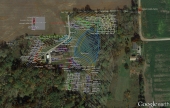I am guessing that this is the right forum. It could be the left forum for all I know.

I have one strip of land on my "pasture" (40 year old fescue sod, with lots of other stuff). It's about 800 square feet (about 80x10). It was under black plastic for a season, and then this year I have potatoes growing there (under wood chips). About 4-5 feet south (uphill) of this strip, is where I moved the black plastic to this year. To move it any further south in the future, means less and less distance (I am running into a jackleg fence at an angle). Perhaps 12-15 feet north (downhill), I have a layer of clear plastic on the ground this year as well. It perhaps covers 90 feet in length. Partly to compare black versus clear for this purpose. Deer seem much more willing to walk (and poke holes into) black plastic, than clear. Black plastic seems to have a lifetime of about 2.5 years.
In the 4 foot wide space, I have 3 mini plantings. Two failed. One I don't know about, maybe next spring it will surprise me (a fern that I planted). But the fescue hay is trying to grow into the strip of wood chips covering potatoes.
In the 15 foot space, I had driven the pickup delivering wood chips for the potatoes (I was trying hilling with wood chips) in there, it was soft because it was wet, and so now there are some ruts (no tire spin) there. I am beginning to think you use enough wood chips to begin with, adding wood chips for hilling is annoying.
Many years ago, I tried trial plots into the fescue sod by cutting out 1x1 foot squares. Doesn't work. The fescue grows at some point, and whatever is growing in the 1x1 gets no light and dies. The fescue might take all the water, and so it dies. The fescue emits allelopathic compounds, which prevent the trial plants from growing. Could be all 3, could be other things.
I've been planting trees elsewhere, nominally using a 2x2 cutout of the fescue sod. But, most of the time I've come along and put a couple of inches of wood chip mulch around these locations to a diameter of 6 feet or more. The trees seem to be doing okay, except where some mistake of mine caused the trees to die.
This year, I cut out seven 2x2 plots for planting squash in the fescue. This was a miserable year here, no heat and too much rain. But, less than half of the squash locations (7x4=28) got beyond the dicot stage. A couple started vines. I think the longest vine was 3 inches or so. I harvested no squash. My intention is to blame this on allelopathy of fescue. In the centre of all those plots, I inserted a Kousa dogwood seed, and maybe next spring I will see dogwoods? I could try the squash again. My intention is to dig 3x3 plots next to these squash locations, to see if 3x3 does any better than 2x2 (or 1x1).
For next year, I have a 4 foot gap. If I put plastic in the middle of the 12-15 foot gap for next year; I could have a couple of smaller than 4 foot gaps. So, I am looking at how big does a garden need to be, to survive in fescue, and how small is a viable patch of fescue.
I have used vinegar as a herbicide in the past. But, the local low price super markets decided to mark up the price of that vinegar more than 10% this year. WHOA! Do I want to use vinegar as a herbicide, if the local retailers are seeing it as a profit centre for their grocery stores?
It isn't that I want to have fescue between my garden plots. I could try mowing. I could place wood chips. I could spray vinegar. Maybe there are other things. I am willing to try ideas.
In order to have some tangible benefit for the local food bank, I think I need to get to the point where I have 1 acre of potatoes growing each year. And other stuff. But, using plastic to "suppress" the fescue to allow potatoes to break up the fescue, and so to produce a number of garden strips is the idea I am thinking about.
I got 2 kinds of seed potatoes from a local Hutterite colony. The red potatoes are supposedly the ones in demand, and I was seeing potatoes with very little to almost totally scab. I had more of the white potatoes, and so far I haven't seen scab. On land which has probably never seen potatoes growing. So, I think the thing I should do is to continue using these white potatoes to "work up" my land, and after a couple of years of potatoes, then think about growing other things.
I do have some tree splitting wedges and a sledge hammer (or two). If the best thing is to put wood borders on a garden (nearly 100 foot long), I can do that.
But I would like suggestions as to how one sets up a bunch of "gardens", so as to produce potatoes and other vegetables. I am pursuing tree planting, which is guilds and stuff as well. Maybe this set of gardens is just temporary?
Thanks!






